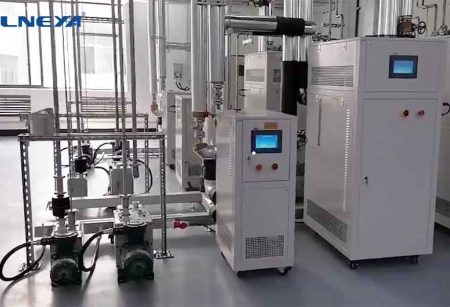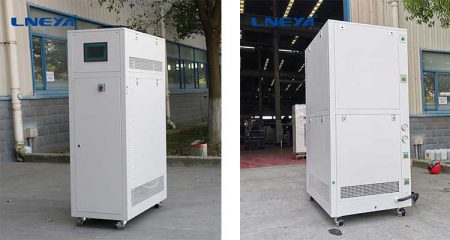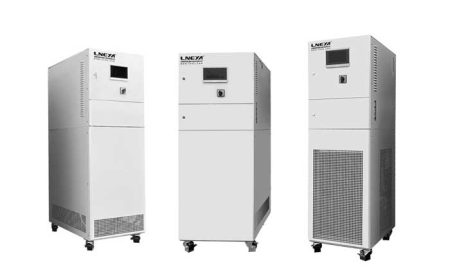Waste Heat Chiller
Kontaktieren Sie uns noch heute für die perfekte Lösung zur Temperaturkontrolle
Structure of waste heat chiller
Waste heat chiller usually consists of components such as heat exchanger, compressor, condenser, throttle valve and evaporator. Among them, the heat exchanger is the core component and is used in the refrigeration process to convert waste heat into refrigerant. The compressor compresses the low-pressure refrigerant into a high-temperature and high-pressure state, and sends it to the heat exchanger to exchange heat with the cooled waste heat. After cooling, the refrigerant enters the evaporator through the throttle valve, and absorbs heat in the evaporator to cause the surrounding medium to The temperature is reduced to achieve the purpose of refrigeration.

The principle of waste heat chiller
The refrigeration principle of waste heat chiller is based on the principle of thermodynamics, which is a refrigeration process that converts waste heat into refrigerant through a heat exchanger. When a waste heat source exists, the coolant in the heat exchanger exchanges heat with the waste heat, converting the waste heat into a refrigeration process. At the same time, the compressor compresses the low-pressure refrigerant into a high-temperature and high-pressure state, and sends it to the heat exchanger to exchange heat with the cooled waste heat. After the refrigerant is cooled, it enters the evaporator through the throttle valve, absorbs heat in the evaporator, and makes the surrounding environment cool. The temperature of the medium is reduced, thereby achieving the purpose of refrigeration.
The first step is waste heat recovery. In the industrial production process, a large amount of waste heat is often generated, which can be recovered through the waste heat recovery system. The waste heat recovery system usually consists of a waste heat exchanger, a waste heat recovery device, a waste heat storage device, etc., through which high-temperature waste heat is converted into low-temperature refrigeration.
The second step is refrigerant circulation. Refrigerant is an important part of the waste heat refrigeration system. The refrigeration effect is achieved through circulating flow. The refrigerant cycle includes four processes: evaporation, compression, condensation and expansion. During the evaporation process, the refrigerant absorbs heat from the low-temperature evaporator and becomes a gas; during the compression process, the refrigerant is compressed into a high-temperature and high-pressure gas; during the condensation process, the refrigerant dissipates heat through the condenser and becomes a liquid :During the expansion process, the refrigerant reduces the pressure through the expansion valve and becomes a low-temperature and low-pressure gas.
The third step is the cooling effect. Through waste heat recovery and refrigerant circulation, the waste heat refrigeration system can achieve cooling effects. During the refrigeration process, the refrigerant absorbs heat from the low-temperature evaporator and takes the heat away to achieve the refrigeration effect. The size of the refrigeration effect depends on factors such as the type of refrigerant, temperature and pressure.

The waste heat chiller has the following advantages:
1. Energy saving: The waste heat chiller uses waste heat for cooling without consuming additional energy.
2. Environmentally friendly: waste heat chiller does not use any harmful substances and will not produce any pollution.
3. High efficiency: The cooling efficiency of the waste heat chiller depends on the temperature and amount of the waste heat source, so it can cool efficiently.
Wir bieten die Entwicklung und Herstellung kompletter Temperaturkontrollsysteme an. Von Standardmodellen bis zu kompletten kundenspezifischen Produkten bis hin zu 900 Tonnen. Wir haben uns auf den Kundenservice spezialisiert und sind bestrebt, jedem Kunden zu helfen, das optimale Temperaturkontrollsystem für seinen spezifischen Bedarf zu finden.
Wir bieten maßgeschneiderte Lösungen, die nicht dem Standard entsprechen. Es sind sowohl einzelne Kühlaggregate als auch kombinierte Kühl- und Heizaggregate erhältlich.
E-Mail: info@lneya.com WeChat ID: +8615251628237 WhatsApp: +86 17851209193

Rückkühler / Umwälzkühler
Die Kältemaschine kann in verschiedenen Industrien und Labors eingesetzt werden und unterstützt kundenspezifische Designs.
| Temperaturbereich | Serie -25°C ~ +30°C | -45°C ~ +30°C Reihe | Serie -60°C ~ -20°C | Serie -80°C ~ -20°C | Serie -120°C ~ -70°C | ||||
| Kühlleistung | 0,8 ~ 30kW | 0,75 ~ 12kW | 0,4 ~ 6kW | 0,2 ~ 6kW | 0,3 ~ 5kW | ||||
| Hinweis: Jeder Temperaturbereich von -150℃ ~ +350℃ und jede Kühlleistung kann angepasst werden | |||||||||
 Kaltwassersätze / Kleinkaltwassersätze
Kaltwassersätze / Kleinkaltwassersätze
Die Kältemaschine kann in verschiedenen Industrien und Labors eingesetzt werden und unterstützt kundenspezifische Designs.
| Temperaturbereich | -18°C ~ +30°C | +5°C ~ +35°C Reihe | |||||||
| Kühlleistung | 0,35 ~ 0,9kW | 1,8 ~ 50kW | |||||||
| Hinweis: Jeder Temperaturbereich von -150℃ ~ +350℃ und jede Kühlleistung kann angepasst werden | |||||||||

Niedertemperatur-Kühlgeräte
Wir haben uns auf die Herstellung von Niedertemperaturkältemaschinen mit einem Temperaturregelbereich von bis zu -150°C spezialisiert, die den Kühlbedarf verschiedener Branchen decken.
| Temperaturbereich | Serie -25°C ~ -5°C | Serie -45°C ~ -10°C | Serie -60°C ~ -10°C | Serie -80°C ~ -30°C | Serie -110°C ~ -50°C | Serie -150°C ~ -110°C | |||
| Kühlleistung | 12 ~ 360kW | 6 ~ 180kW | 6 ~ 180kW | 4 ~ 180kW | 2 ~ 120kW | 2,5 ~ 11kW | |||
| Hinweis: Jeder Temperaturbereich von -150℃ ~ +350℃ und jede Kühlleistung kann angepasst werden | |||||||||

Hochtemperatur-Kühlgeräte
Die Kältemaschine kann in verschiedenen Industrien und Labors eingesetzt werden und unterstützt kundenspezifische Designs.
| Temperaturbereich | +5°C ~ +40°C | -25°C ~ +40°C | -45°C ~ +40°C | -80°C ~ +80°C | -100°C ~ +80°C | ||||
| Kühlleistung | 6 ~ 40kW | 2 ~ 15kW | 1 ~ 8kW | 0,6 ~ 3kW | 1,5 ~ 3kW | ||||
| Hinweis: Jeder Temperaturbereich von -150℃ ~ +350℃ und jede Kühlleistung kann angepasst werden | |||||||||
Kühlen und Heizen Kaltwassersätze

Kühlen und Heizen Kaltwassersätze
Temperaturregelbereich: -120°C bis +350°C
Kühl- und Heizungsthermostate, die in verschiedenen Industriezweigen weit verbreitet sind.
| Temperaturbereich | Serie -10 ~ +150°C | Serie -25 ~ +200°C | Serie -25 ~ +300°C | Serie -45 ~ +250°C | Serie -45 ~ +300°C | Serie -60 ~ +250°C | Serie -60 ~ +300°C | Serie -70 ~ +250°C | Serie -80 ~ +250°C | Serie -90 ~ +250°C | Serie -100 ~ +100°C | ||
| Kühlleistung | 1,5 ~ 15kW | 1 ~ 200kW | 1 ~ 200kW | 0,45 ~ 200kW | 0,9 ~ 25kW | 0,25 ~ 60kW | 0,75 ~ 25kW | 0,4 ~ 15kW | 0,3 ~ 80kW | 0,2 ~ 80kW | 0,45 ~ 80kW | ||
| Hinweis: Jeder Temperaturbereich von -150℃ ~ +350℃ und jede Kühlleistung kann angepasst werden | |||||||||||||

Kühlgeräte mit Rücklaufheizung
Temperaturregelbereich: -45°C bis +250°C
| Temperaturbereich | Serie -25°C ~ +200°C | Serie -45°C ~ +250°C | |||||||
| Kühlleistung | 1 ~ 15kW | 0,25 ~ 15kW | |||||||
| Hinweis: Jeder Temperaturbereich von -150℃ ~ +350℃ und jede Kühlleistung kann angepasst werden | |||||||||
 LNEYA
LNEYA
 简体中文
简体中文


















































































